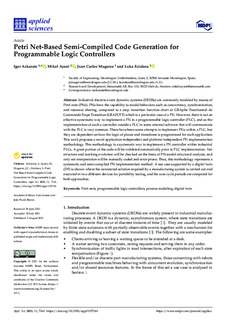
Izenburua
Petri net-based semi-compiled code generation for programmable logic controllersArgitalpen data
2021Bertsioa
Bertsio argitaratuaDokumentu-mota
ArtikuluaArtikuluaHizkuntza
IngelesaEskubideak
© 2021 by the authors. Licensee MDPISarbidea
Sarbide irekiaArgitaratzailearen bertsioa
https://doi.org/10.3390/app11157161Non argitaratua
Applied Sciences Vol. 11. N. 151. N. artículo 7161, 2021Argitaratzailea
MDPIGako-hitzak
Petri netsprogrammable logic controllers
process modeling
digital twin
Laburpena
Industrial discrete event dynamic systems (DEDSs) are commonly modeled by means of Petri nets (PNs). PNs have the capability to model behaviors such as concurrency, synchronization, and resource shari ... [+]
Industrial discrete event dynamic systems (DEDSs) are commonly modeled by means of Petri nets (PNs). PNs have the capability to model behaviors such as concurrency, synchronization, and resource sharing, compared to a step transition function chart or GRAphe Fonctionnel de Commande Etape Transition (GRAFCET) which is a particular case of a PN. However, there is not an effective systematic way to implement a PN in a programmable logic controller (PLC), and so the implementation of such a controller outside a PLC in some external software that will communicate with the PLC is very common. There have been some attempts to implement PNs within a PLC, but they are dependent on how the logic of places and transitions is programmed for each application. This work proposes a novel application-independent and platform-independent PN implementation methodology. This methodology is a systematic way to implement a PN controller within industrial PLCs. A great portion of the code will be validated automatically prior to PLC implementation. Net structure and marking evolution will be checked on the basis of PN model structural analysis, and only net interpretation will be manually coded and error-prone. Thus, this methodology represents a systematic and semi-compiled PN implementation method. A use case supported by a digital twin (DT) is shown where the automated solution required by a manufacturing system is carried out and executed in two different devices for portability testing, and the scan cycle periods are compared for both approaches. [-]
Bildumak
Item honek honako baimen-fitxategi hauek dauzka asoziatuta:





















